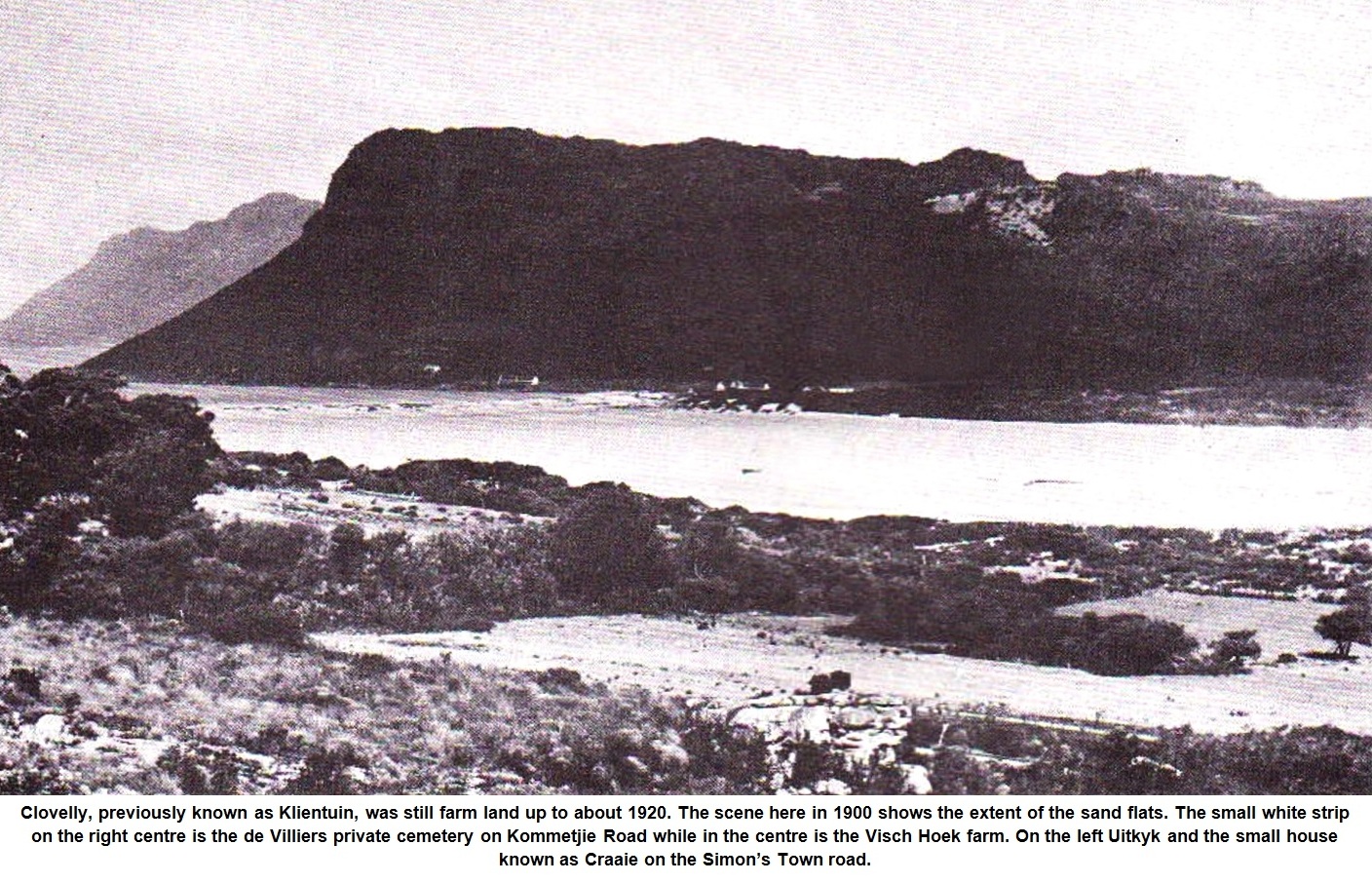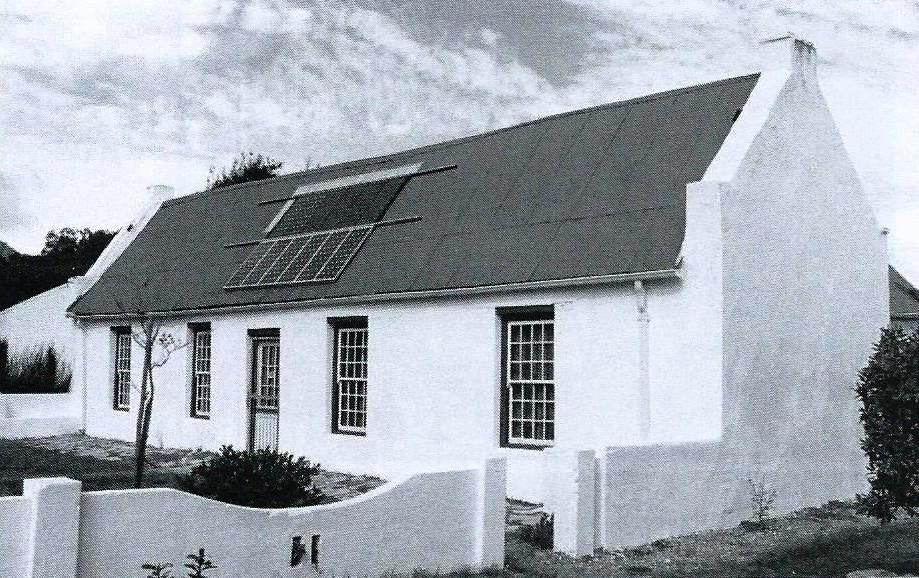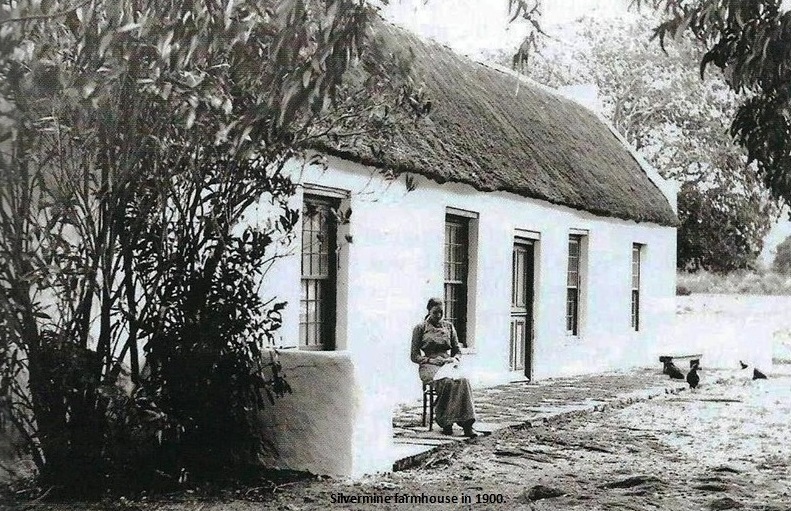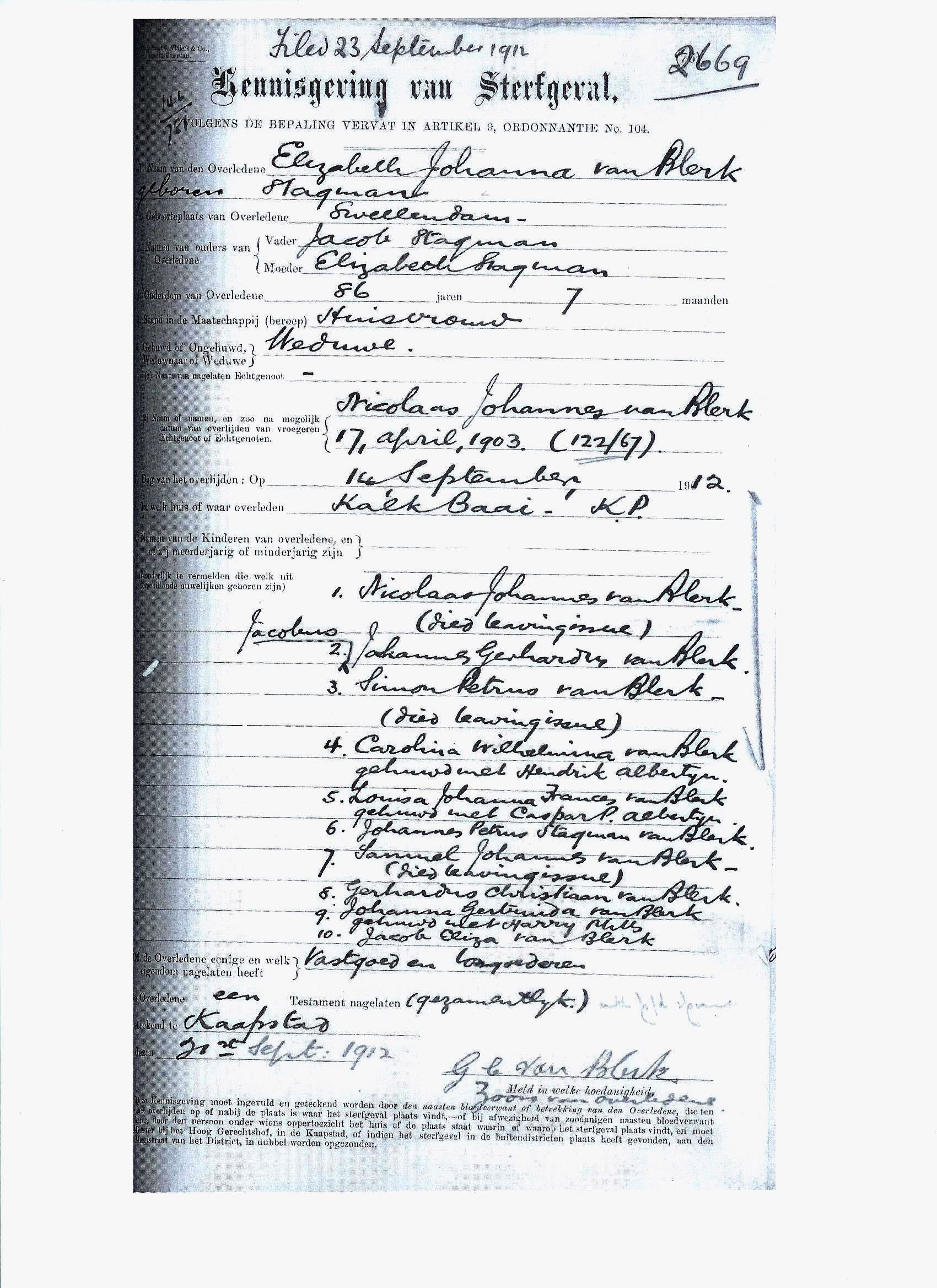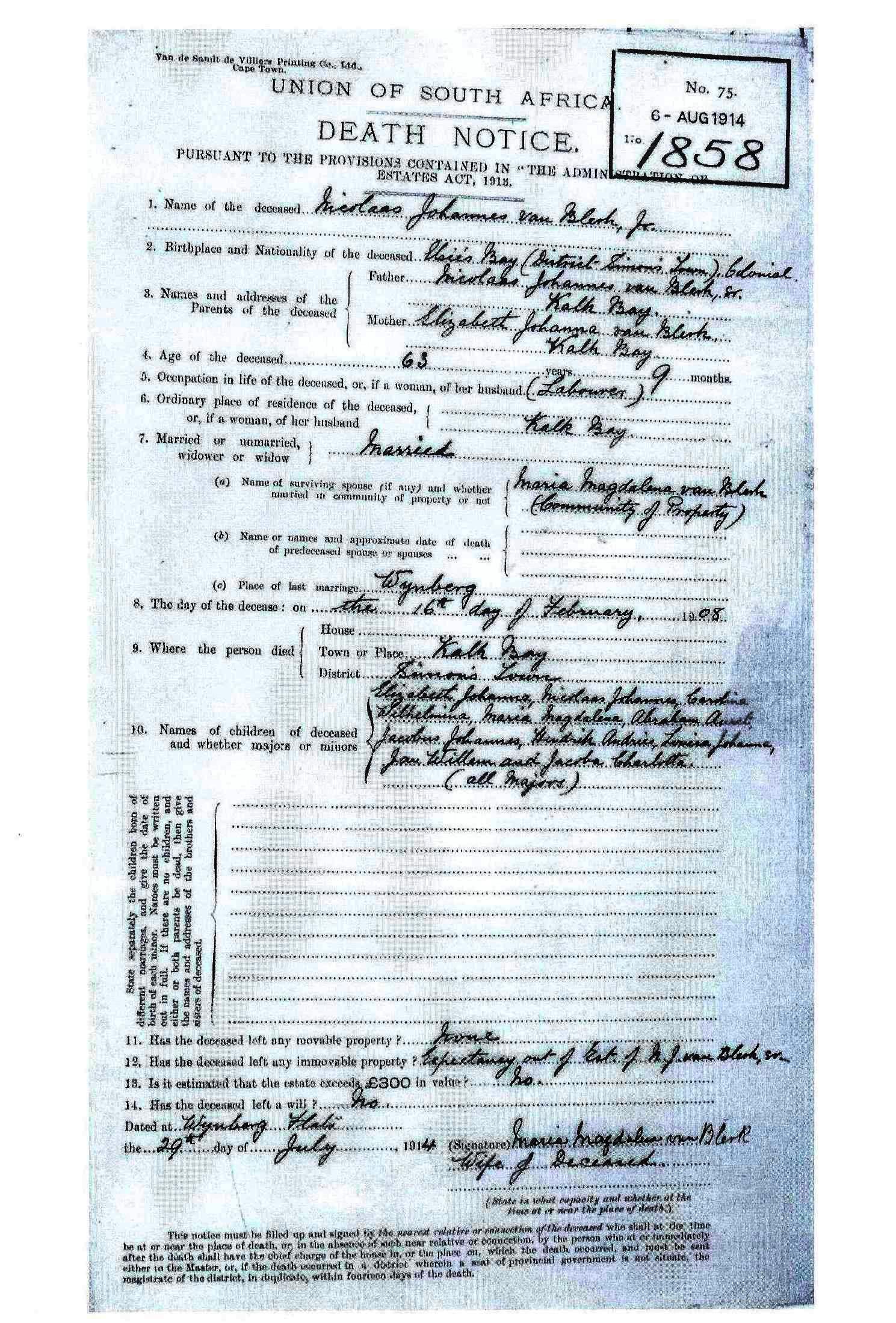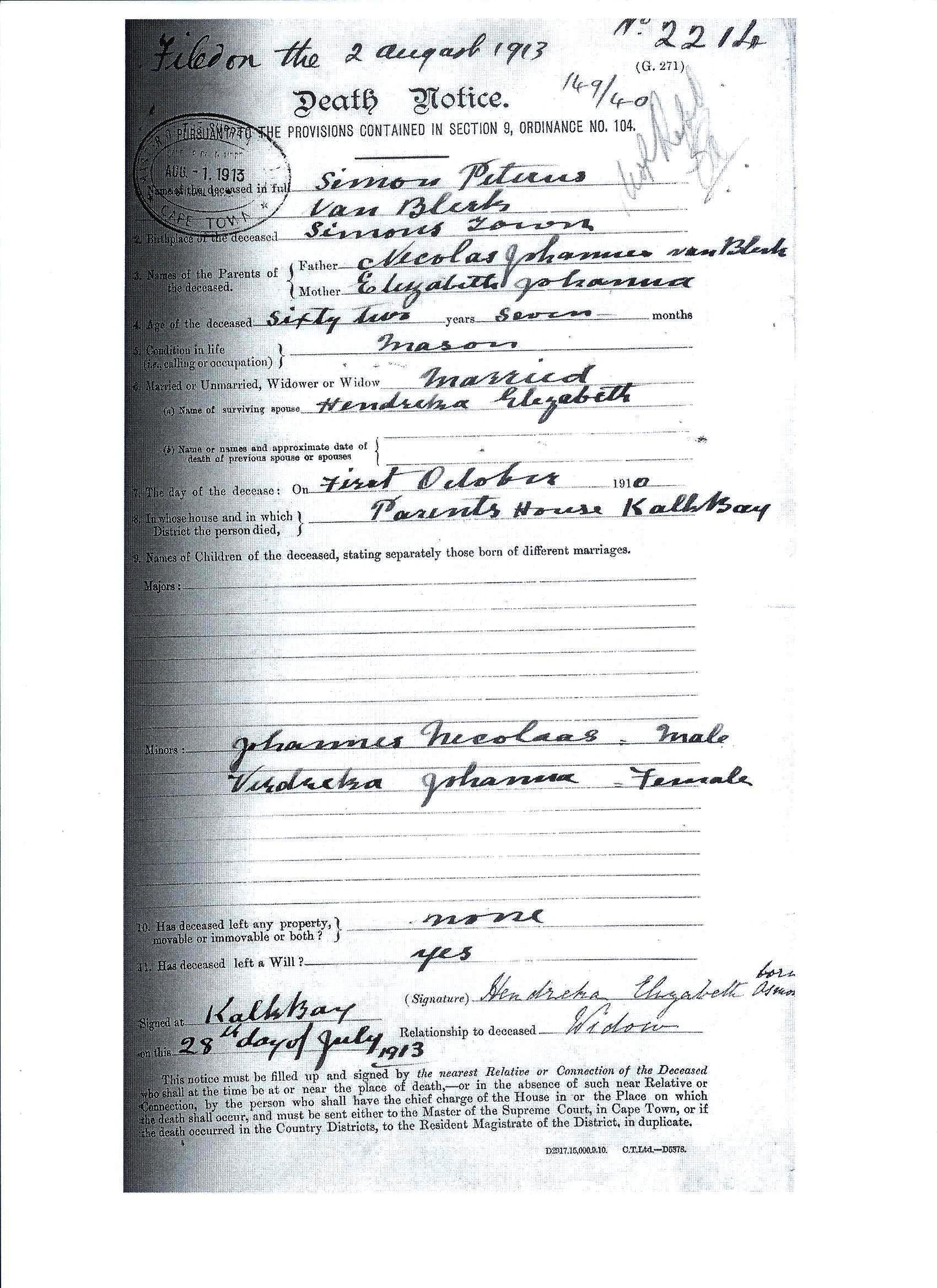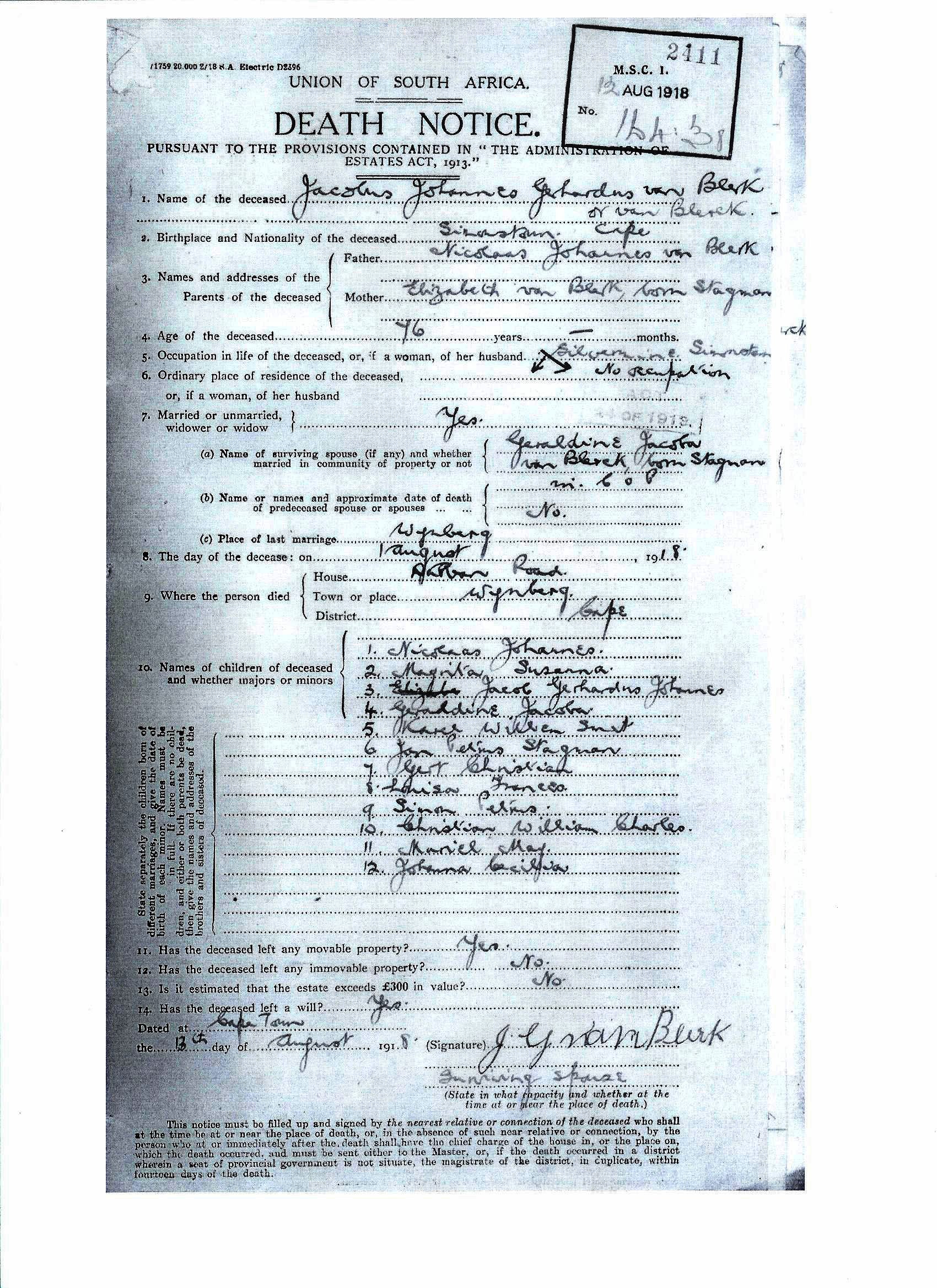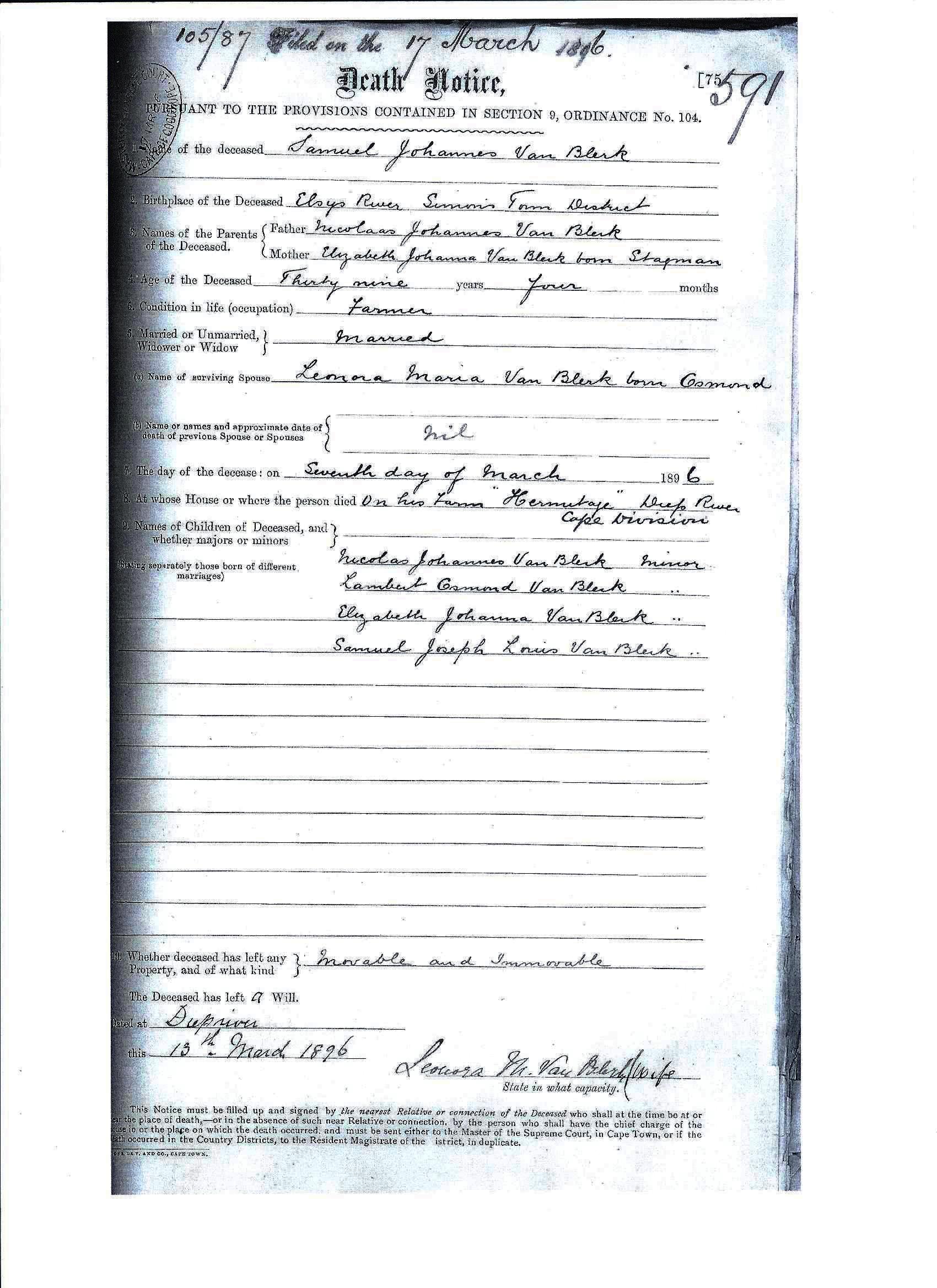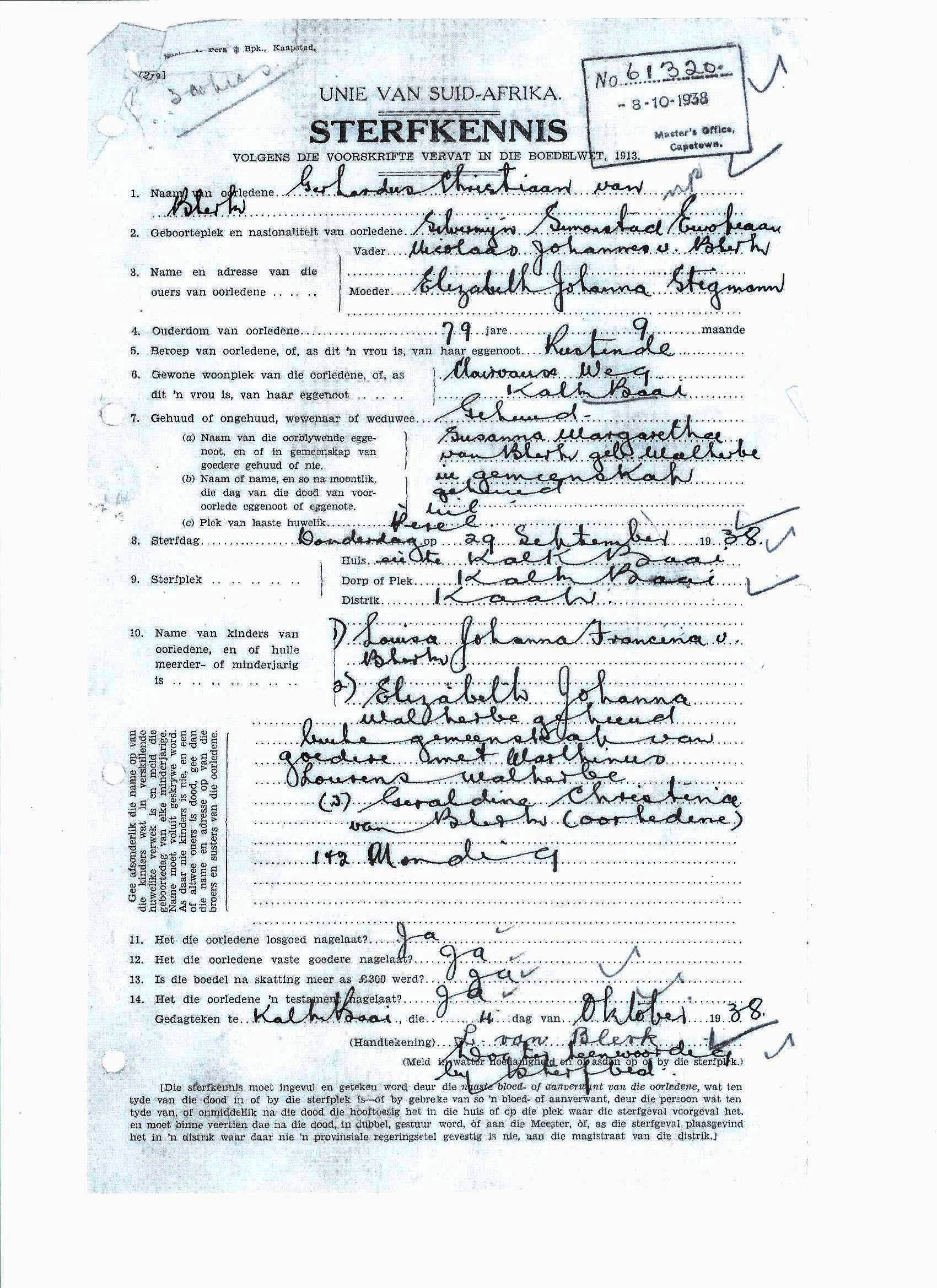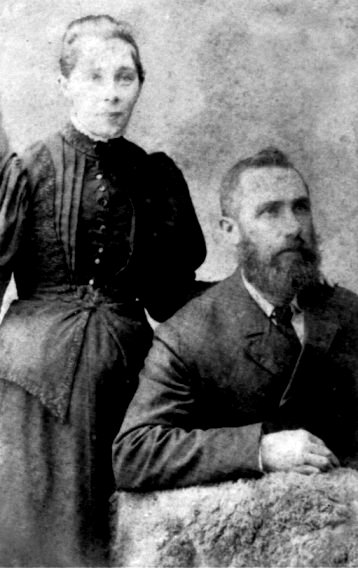

 Nicolaas Johannes van Blerk
Nicolaas Johannes van Blerk 


General Notes
Extracts from ‘THE FAMILIES AND FARMS OF THE SOUTH PENINSULA AND CAPE POINT’ by Michael Walker
KLEINTUIN p56
Kleintuin or lot C had an area of 530 morgen and is an agricultural lot along the banks of the Silvermine River. First transferred to J.A. Hurter on 16th March 1827, after which it was transferred to Nicolaas van Blerk and remained in the van Blerk family for many years. The farm was passed on from Nicolaas to his son Nicolaas Johannes van Blerk. ‘The Homestead’ at Kleintuin is the oldest house in Clovelly and was built by the van Blerks in 1835 and it is possible that the ‘Die Opstal’ or ‘The Homestead’ at Kalk Bay was named after this house. It was proclaimed a National Monument in 17th August 1984 and can be found in Montrose Avenue, Clovelly.
The farm inventory (previously the opgraaf rol) 0f the early 1840’s recorded:-
Owner: Nicolaas van Blerk. One woman, four sons, two daughters, two Hottentot males over 16, two under 16, two Hottentot females under 16, two under 16, three male slaves over 16, two under 16, two female slaves over 20, two under 20, one riding horse, twenty oxen, twenty breeding cattle, six muids of oats sown.
The van Blerk family supplied vegetables, fruit, dairy products and poultry to the communities of Kalk Bay, Fish Hoek and Simon’s Town for many years.
ZILVERMYN (SILVERMINE) FARM p47
In 1857 Nicolaas Johannes van Blerk bought the farm from the insolvent estate of Jan Greig de Villiers. The land lay along the upper banks of the Lower Silvermine River and bordered on Kleintuin. Size of the farm was 411 morgen. The farm house that was originally built by William Ferdinand Kirsten in 1813 still stands today. The total size of the two farms would have been 941 morgen.
Extracts from Fish Hoek Valley by Malcolm Cobern:-
Page 85
In 1824 a taxman visited the main five farms in the Silvermine river valley for the purpose of determining what taxes should be paid. The farms were Imhoffs Gift – Mr P. Rocher, Poespaskraal (The Homestead) – Mr I.N. Joone, Klientuin (Clovelly) – Mr N.J. van Blerk, Noordhoek Farm (Goede Hoop) – Mr A. Hare and Silvermine – Mr I.J. Hurter
Page 95
Lot C was 530 morgen in extent and was called Kleintuin, which today is Clovelly. The border was the river and it extended along the Kalk Bay road for about 200 yards and then up to the top of ‘Clovelly Kop’. This land was for farming and contained a number of cultivated fields.
In 1824 N.J. van Blerk had 1 riding horse, 20 oxen, 20 breeding cattle, 6 muicls of sown oats and paid a tax of 3 Pounds and 4 Pence.
The following undated cutting from the False Bay Echo was published about 2003. It is by Joy Coburn, the curator of the Fish Hoek Museum.
THE NOORDHOEK SALT PAN.
When farming began in the Noordhoek area in the 1700’s, the cattle soon discovered that the vlei, which dried up in the summer, provided a good salt lick. The early farmers probably used the salt for their own consumption, but it was not until about 1830 that the salt was harvested commercially. No one seemed to have had the expertise to turn it into a successful business and it changed hands several times until a Mr van Blerk of Kalk Bay, who was then the owner of Clovelly, bought the rights to work the pan.
With sufficient finance, and proper methods of collecting the salt, he raised the output from 65 bags a year to 6 000 bags a year, so he obviously had a good business operation. The salt was very pure and for many years was sent all over the country. Eventually, as more farming was taking place in the valley, cattle roaming in what was an unfenced area started damaging and fouling the pans. Not being dependent on the business for his income the owner lost interest and allowed the salt pan to return to its natural state.
The following piece of information was extracted from The Cape Odyssey. Vol 3. Issue 4 dated April/May 2003. Page 21. 3rd paragraph. Perhaps it refers to J P (Jan) van Blerk’s father. More likely, perhaps, his grandfather.
NOORDHOEK.
There was a saltpan nearby that was the source of considerable activity. A traveller inspected the enterprise and had this to say, early in 20th century. “I did look around and saw how the salt was gathered but only once a year. From information given me by the most reliable authority, I found the saltpan and land is some 132 acres in extent and was first worked about 70 or 80 years ago (about 1830—1840) on a very small scale. The old method was to wait until the rain water was evaporated and the salt laid in sight once a year only. I found Mr van Blerk of Kalk Bay, had worked it for many years and one year his output grew from 65 bags to 6 500 bags. It was a matter of taking care to prevent cattle wandering over the pan and not allowing sand to be washed down from the hills so that the salt could scarcely come through the sand and dirt on the surface of the pan.” The visitor was most enthusiastic about the future of the saltpan and declared that it was better than any diamond or gold mine in the Orange River Colony and the Transvaal.
-
Whereabouts
-
Nicolaas Johannes lived in Kleintuin, Clovelly.
-
-
Ancestor Pedigree Chart
-


 - b.1714 in Venlo, Province of Limburg, Netherlands and the van Blerk family progenitor SA. d.22 Oct 1758 in Cape of Good Hope
- b.1714 in Venlo, Province of Limburg, Netherlands and the van Blerk family progenitor SA. d.22 Oct 1758 in Cape of Good Hope

 - b.18 Apr 1745 in Cape Town d.02 Jun 1812 in Stellenbosch
- b.18 Apr 1745 in Cape Town d.02 Jun 1812 in Stellenbosch






 - d.27 Aug 1796 in Cape of Good Hope
- d.27 Aug 1796 in Cape of Good Hope



 - b. in Amsterdam, Netherlands
- b. in Amsterdam, Netherlands
 - b.07 Nov 1779 in Cape Town d.21 Jan 1838 in van Blerk farm, Elze River, Simons Town
- b.07 Nov 1779 in Cape Town d.21 Jan 1838 in van Blerk farm, Elze River, Simons Town




 - d.12 Nov 1787 in Stellenbosch
- d.12 Nov 1787 in Stellenbosch




- b.14 Aug 1825 in van Blerk farm, Elze River, Simons Town d.12 Apr 1923 in Kalk Bay


 - b.14 Nov 1790 in Stellenbosch d.22 Dec 1834 in van Blerk farm, Elze River, Simons Town
- b.14 Nov 1790 in Stellenbosch d.22 Dec 1834 in van Blerk farm, Elze River, Simons Town


-
Pictures
They had six sons and four daughters, named Nicolaas Johannes, Simon Petrus, Jacobus Johannes Gerhardus, Samuel Johannes, Gerhardus Christiaan, Johannes Petrus Stegman, Carolina Wilhelmina, Johanna Jacoba Gertruida, Louaisa Johanna Francis and Jacoba Eliza.
-
Children
 Nicolaas Johannes van Blerk
Nicolaas Johannes van Blerk
Nicolaas Johannes was born on May 4th, 1844 in van Blerk farm, Else River, Simons Town. He died at the age of 63 on February 16th, 1908 in Kalk Bay. He was buried at the Homestead property - now somewhere under Lock Road.
 Simon Petrus van Blerk
Simon Petrus van Blerk
Simon Petrus was born in 1848 in Simonstown. He died at the age of 62 on October 1st, 1910 in Kalk Bay.
 Carolina Wilhelmina van Blerk (Albertyn)
Carolina Wilhelmina van Blerk (Albertyn)
Carolina Wilhelmina was born in 1850. She died at the age of 78 on September 18th, 1928 in Raymond, Rosemead Avenue, Kenilworth.
 Jacobus Johannes Gerhardus van Blerk
Jacobus Johannes Gerhardus van Blerk
Jacobus Johannes Gerhardus was born in 1852 in Simonstown. He died at the age of 66 on August 1st, 1918 in Wynberg.
 Samuel Johannes van Blerk
Samuel Johannes van Blerk
Samuel Johannes was born on October 29th, 1856 in Simonstown. He died at the age of 39 on March 7th, 1896 in Diep River. He was buried at the St. John's Cemetery, Wynberg, Cape Town.
 Gerhardus Christiaan van Blerk
Gerhardus Christiaan van Blerk
Gerhardus Christiaan was born on December 29th, 1858 in Silvermine, Noord Hoek. He died at the age of 79 on September 29th, 1938 in Kalk Bay. He was buried at the Muizenberg Municipal Cemetery, Cape.
 Johannes Petrus Stegman van Blerk
Johannes Petrus Stegman van Blerk
Johannes Petrus Stegman was born in 1865 in Kleintuin, Clovelly. He died at the age of 61 on July 20th, 1926 at Oasis, Lakeside, Cape.
 Johanna Jacoba Gertruida van Blerk (Mills)
Johanna Jacoba Gertruida van Blerk (Mills)
Johanna Jacoba Gertruida was born in 1869. She died at the age of 72 on August 2nd, 1941. She was buried in Woltemade Cemetery, Maitland.
Sources/Citations
South African National Archives, Cape Town @ Death Notice:- MOOC 6/9/474 1475, THE FAMILIES AND FARMS OF THE SOUTH PENINSULA AND CAPE POINT’ by Michael Walker, Find A Grave Index
South African National Archives, Cape Town @ Death Notice:- MOOC 6/9/474 1475, THE FAMILIES AND FARMS OF THE SOUTH PENINSULA AND CAPE POINT’ by Michael Walker, Find A Grave Index
Page last modified
This page is within a frameset. View the entire genealogy report of van Blerk families, or surname index of van Blerk pedigrees or report summary van Blerk heritage from 'van Blerk/van Blerck family tree'.
Drawing a Family Tree.
Copyright © 2011 GenoPro Inc. All rights reserved.
